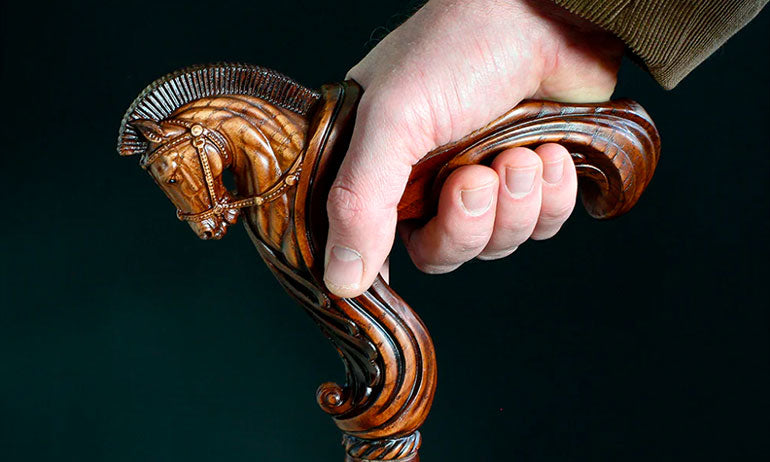Masterpieces in Wood: Discovering the Beauty and Functionality of Hand-Carved Canes
Posted by ELIZABETH CARROLL

TL;DR
Hand-carved canes are unique and artistic walking aids, highly valued for their craftsmanship and functionality. They date back centuries ago, primarily used as status symbols for the wealthy. Material choices range from wood to horn, bone, and metal. Wood is the most popular choice because of its strength and durability. Proper care and maintenance, including regular cleaning and oiling, is essential for the longevity of the cane. With endless possibilities for design and patterns, a hand-carved cane is a fashionable accessory that reflects your personality and style.
In the world of canes, there’s a special place for the hand-carved ones, those walking canes meticulously crafted and designed by hand. Hand-carved canes have a long and fascinating history, dating back centuries to when they were primarily used as status symbols for the wealthy. They are highly valued for their unique and artistic qualities and functionality as walking aids and because they can be customized to reflect the personality and interests of the owner, making them a highly personal and treasured possession. Besides, hand-carving a cane is a highly skilled art form that requires patience, precision, and attention to detail, resulting in a beautifully crafted work of art.
Some of the most famous examples of these beautiful works of art have been owned by notable figures. For example, former US President Franklin D. Roosevelt was known for his collection of hand-carved canes, which he used both as walking aids and as accessories to complement his stylish attire. Another famous example is the cane owned by the magician Harry Houdini, which was carved from a single piece of wood and had a hidden compartment for holding lock-picking tools.
Balancing Style and Functionality: Material Choices for Hand-Carved Canes
The materials used in hand-carved canes can vary depending on the artist’s preference and the design of the cane. Wood is popular because it’s strong and long lasting. Maple, hickory, and mahogany are also commonly used.
In addition to wood, hand-carved canes may feature accents made from other materials such as horn, bone, and metal. These materials can add texture and visual interest to the cane. However, it’s important to note that while these accents may enhance the cane’s appearance, they can also add weight, making it less practical as a walking aid.
In the world of fashionable canes, the material you choose for a hand-carved cane is just as important as the design. Not only should it be strong enough to support the user's weight, but it should also be comfortable to hold and durable enough to withstand daily use. However, the visual aesthetic and practicality of the material is just as crucial. The right material can complement the design of the cane and enhance its overall beauty, making it a functional and fashionable accessory.
The Endless Possibilities of Hand-Carved Cane Designs and Patterns
Hand-carved canes are not just functional, they’re also a fashion statement that shows off your personality. Why settle for a plain, dull cane when you can have a unique and customized design that reflects your interests? The possibilities for your cane are endless, from sports teams to animals, nature scenes to intricate filigree designs. Who says walking aids can’t be fashionable? You can strut your stuff with confidence and style with a hand-carved cane. Don’t be surprised if people ask where you got it from!
The Fascinating Process of Hand-Carving Canes
Hand-carving a cane is not just a simple task but a highly skilled art form that requires patience, precision, and a true passion for the craft. Carving a hand-carved cane begins with a rough design outline on the wood, which the artist carefully and skillfully carves into a beautiful work of art. Depending on the design, various techniques are used, from intricate filigree carving to more straightforward geometric shapes. Next, carving tools such as chisels and gouges remove the excess wood, resulting in a beautiful shape and texture that defines the design. The time taken to create a hand-carved cane depends on the complexity of the design, taking from a few hours to several days to perfect.
Tips and Tricks to Caring for Your Hand-Carved Cane
Proper care and maintenance of a hand-carved cane are essential to ensure its longevity and usability.
- Regularly clean and oil the wood of the hand-carved cane to maintain its good condition.
- Use a soft cloth and a small amount of wood oil for cleaning.
- Store the cane in a dry place to prevent warping or cracking. Or much better: get a cane stand to display the work of art of your hand-carved cane!
- Address any issues promptly, such as a loose handle or a crack in the wood, to prevent further damage.
- Consider simple repairs to restore the hand-carved cane to its original condition.
An Elegant Statement Piece
In conclusion, hand-carved canes are more than just functional walking aids, they’re works of art that reflect the user’s personality and interests. Whether you choose a traditional or custom design, your hand-carved cane is a statement piece that reflects your style and elegance. Of course, proper care and maintenance are essential to ensure its longevity and usability, but with a little attention and care, your hand-carved cane will last for many years to come, providing you with both functionality and beauty. So why not invest in a hand-carved cane today and start enjoying the timeless elegance and sophistication that it brings?

